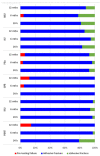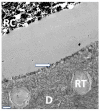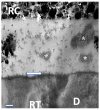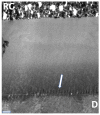Dentin Bonding Performance of Universal Adhesives in Primary Teeth In Vitro
- PMID: 37687643
- PMCID: PMC10488408
- DOI: 10.3390/ma16175948
Dentin Bonding Performance of Universal Adhesives in Primary Teeth In Vitro
Abstract
(1) Background: The aim of this in vitro study was to evaluate the micro-tensile bond strength (µ-TBS) of universal adhesives to primary tooth dentin after different storage periods. (2) Methods: Dentin of 100 extracted primary molars was exposed. Dentin surfaces were bonded with six universal adhesives (Adhese®Universal [AU], All-Bond Universal® [ABU], G-Premio Bond [GPB], iBond®Universal [IBU], Prime&Bond active™ [PBa], and Prime&Bond®NT as control [PBN]) and restored with a resin composite build-up (Filtek™ Z250). After 24 h, 6 months, and 12 months of water storage, specimens were cut into sticks, and µ-TBS was measured and analyzed using one-way ANOVA (p < 0.05) for normal distributions and the Mann-Whitney U-test (p < 0.05) for non-normal distribution. Pretesting failures were recorded as 0 MPa. Fracture modes were analyzed under a fluorescence microscope; interfaces were visualized with SEM/TEM. (3) Results: Compared with the reference group (PBN: 32.5/31.2 MPa after 6/12 months), two adhesives showed a significantly higher bond strength after 6 months (AU: 44.1 MPa, ABU: 40.9 MPa; p < 0.05) and one adhesive after 12 months (AU: 42.9 MPa, p < 0.05). GPB revealed significantly lower bond strengths in all storage groups (16.9/15.5/10.9 MPa after 24 h/6 months/12 months; p < 0.05). AU and IBU did not suffer pre-test-failures [PTF]. (4) Conclusions: After 12 months, PBN, IBU, AU, and GPB showed significantly lower results compared ithw initial µ-TBS, whereas AU revealed the highest µ-TBS and no PTF.
Keywords: dentin; microtensile bond strength; pre-test failure; primary teeth; universal adhesives.
Conflict of interest statement
R.F. received grants and lecture honoraria from Ivoclar, 3M, GC, Kulzer, and Dentsply. N.K. received grants and lecture honoraria from Ivoclar, 3M, GC, Kulzer, and Dentsply. N.D. and S.L. declare no conflict of interest.
Figures












References
-
- Krämer N., Frankenberger R. Restorative therapy in deciduous teeth. Oralprophyl. Kinderzahnheilkd. 2004;26:78–84.
-
- Meereis C.T.W., Münchow E.A., de Oliveira da Rosa W.L., da Silva A.F., Piva E. Polymerization shrinkage stress of resin-based dental materials: A systematic review and meta-analyses of composition strategies. J. Mech. Behav. Biomed. Mater. 2018;82:268–281. doi: 10.1016/j.jmbbm.2018.03.019. - DOI - PubMed
-
- da Silva C.L., Cavalheiro C.P., Gimenez T., Imparato J.C.P., Bussadori S.K., Lenzi T.L. Bonding Performance of Universal and Contemporary Adhesives in Primary Teeth: A Systematic Review and Network Meta-Analysis of In Vitro Studies. Pediatr. Dent. 2021;43:170–177. - PubMed
LinkOut - more resources
Full Text Sources
Research Materials

